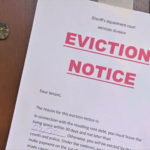A reference of Minnesota Eviction Laws, and steps of the Minnesota eviction process for landlords and renters, updated 2021.
- What are the reasons for eviction under Minnesota eviction laws?
- Nonpayment of rent (Minn. Stat. Ann. §504B.291).
- Non-compliance with the lease (Minn. Stat. Ann. §504B.285(sub. 5)).
- Illegal activity (Minn. Stat. Ann. §504B.171).
- Substantial damage to property (Minn. Stat. Ann. §504B.165).
- Tenant remains in possession of the dwelling unit after the occupancy period without the landlord’s permission (Minn. Stat. Ann. §504B.141(b)).
- What notice do Minnesota eviction laws require that landlords provide tenants before starting the eviction process?
- For evictions based on non-payment of rent, Minnesota requires a 14-day notice. (Minn. Stat. Ann. §504B.135(b)). Unless the landlord is also evicting the tenant for a material violation of the lease, the tenant can avoid eviction at any time before possession has been turned over by paying the amount of past due rent, interest, costs of the action, and $5. (Minn. Stat. Ann. §504B.291).
- For evictions based on the tenant’s non-compliance of the lease agreement, the landlord must give a 14-day notice. (Minn. Stat. Ann. §504B.285(sub. 5)).
- Landlords can begin an immediate eviction if the tenant uses the property for an illegal use of a controlled substance, prostitution, or to store stolen property or an illegal firearm. (Minn. Stat. Ann. §504B.171).
- Landlords can begin an immediate eviction if the tenant causes substantial damage to the property. (Minn. Stat. Ann. §504B.165).
- For evictions based on the tenant remaining in possession of the rental property after the expiration of the lease, the landlord must provide three months’ notice or one payment interval, whichever is less. (Minn. Stat. Ann. §504B.135(b)).
- Do Minnesota eviction laws allow landlords to use “self-help eviction” methods, such as locking a tenant out of the rental unit or shutting off the utilities?
- No. Minnesota law prohibits a landlord from unlawfully removing or excluding a tenant, including causing their utilities to be cut off. The tenant can recover three times the amount of damages they sustained or $500, whichever is greater, plus reasonable attorney’s fees. (Minn. Stat. Ann. §504B.225).
Eviction Process in Minnesota: Step-by-Step
The eviction process in Minnesota is called an Unlawful Detainer Action. The eviction process in Minnesota involves the following process.
- Landlord sends the eviction notice.
The landlord must provide appropriate type of notice to the tenant that explains the reason for eviction. The landlord should send this via certified first-class mail so there is a record the tenant received it.
- Landlord files a summons and complaint
The landlord begins the official eviction process in Minnesota by filing legal paperwork at the local district or housing court. This includes the summons, which states that a legal action is being taken against the tenant, and a complaint, which sets out the legal basis for the eviction. The landlord pays the filing fee and the court provides a hearing date.
- Landlord serves the tenant
The landlord has the tenant legally served through a private process server or the sheriff’s office at least seven days before the earing date. The landlord must file an affidavit of personal service form to the court at least three days before the hearing that shows the tenant was served.
- Tenant files an answer
The tenant can file an answer to the complaint if they are contesting the eviction. If the basis for eviction is non-payment of rent, the tenant can pay the amount due up to the hearing date to avoid the eviction.
- Attend the hearing
The parties attend the court hearing and present their case. For illegal activity evictions, the hearing is held five to seven days after the summons is issued. For all other evictions, the hearing is held seven to fourteen days after the issuance of the summons.
- Landlord obtains a writ of recovery of premises and order to vacate
If the tenant did not answer or the court rules in the landlord’s favor, it immediately issues a Writ of Recovery of Premises and Order to Vacate, which orders the tenant to vacate the property within 24 hours. If the tenant does not move out when required, the landlord schedules a move-out date with the sheriff and notifies the tenant of the date and time.







